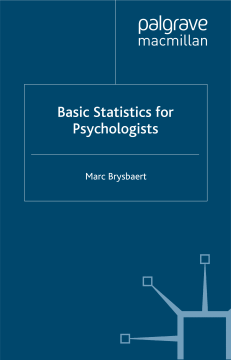
Additional Information
Book Details
Abstract
Basic Statistics for Psychologists combines clear explanations of statistical concepts and tests with a guide to using SPSS, providing an invaluable resource for psychology students. Highly readable and with innovative learning features throughout, this book offers a comprehensive introduction to statistics and their use in social science
"I very much liked the overall approach of the book. It is well structured and student friendly."Judi Smith, School of Psychology, University of Liverpool, UK
"A comprehensive core text that covers all areas of undergraduate statistics and is easy to read. The formulas and calculations are well-presented and explained with a clear overall approach and a logical order of topics. It is a useful resource for psychology students and a helpful introduction to statistics in general."
Toon Cillessen, Nijmegen, Netherlands
MARC BRYSBAERT is currently Research Professor of Psychology at Ghent University, Belgium. Previously he was Professor of Psychology at Royal Holloway, University of London, where he taught both statistics and research methods and developed this textbook.
Marc has extensive publishing experience and has written the market-leading book on 'Conceptual and Historical Issues in Psychology', published by Pearson, as well as a Dutch Handbook of Psychology, and more.
An entry level statistics text that provides a firm and logical foundation for building students' statistical knowledge and confidence. Combines clear explanations of concepts and tests with concise guide to using SPSS. In addition, detailed guides to using Excel and R in conjunction with this book are available on its companion website.
With an engaging modern design and plenty of student-friendly pedagogical features to support the reader, including tips performance and learning checks and recaps, lecturers can be reassured that their students will gain a comprehensive understanding of the 'maths behind stats', taking the fear out of this sometimes difficult-to-grasp subject.
Table of Contents
| Section Title | Page | Action | Price |
|---|---|---|---|
| Cover | Cover | ||
| Table of contents | iii | ||
| Preface | viii | ||
| Tour of book | xii | ||
| Symbols and abbreviations | xiv | ||
| 1 Using statistics in psychology research | 1 | ||
| 2 Summarising data using the frequency distribution | 25 | ||
| 3 Summarising data using measures of central tendency | 59 | ||
| 4 Summarising data using measures of variability | 76 | ||
| 5 Standardised scores, normal distribution and probability | 92 | ||
| 6 Using the t-test to measure the difference between independent groups | 122 | ||
| 7 Interpreting the results of a statistical test | 162 | ||
| 8 Non-parametric tests of difference between independent groups | 199 | ||
| 9 Using the t-test to measure change in related samples | 223 | ||
| 10 Non-parametric tests to measure changes in related samples | 243 | ||
| 11 Improving predictions through the Pearson correlation coefficient | 261 | ||
| 12 Improving predictions through non-parametric tests | 298 | ||
| 13 Using analysis of variance for multiple independent variables | 319 | ||
| 14 Going further: more than two levels and multiple predictors | 357 | ||
| References | 391 | ||
| Appendices | 393 | ||
| Index | 407 |
